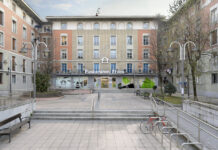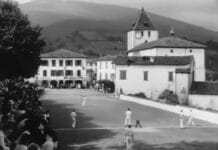This article was translated by John R. Bopp
Gure aita cerue tan aicena. Sanctifica bedi sure Icena
That is how the Lord’s Prayer began at the beginning of the 18th century in the Biscaina/Cantabrica language, according to a map of languages spoken in Europe, which was found in the book Synopsis Universae Philologiae, published between 1730-1741 (depending on who you ask) in Nuremberg by Gottfried Hensel (Godofredus Henselius, 1687-1767), dean in Hirschberg (Jelenia Góra), Lower Silesia.
This amazing map sheds some light on some of the controversies that some have tried to start in an attempt to minimize the impact of the Basque language, and the Basques themselves, in history.
- The first controversy may not be the most important, but it isn’t the least either, and has to do with the use at the time of “Cantabrian” and “Biscayne” as synonyms for “Basque”. This might help clear up some of the arguments about the terms that some project onto modern names (of dubious origin) in history, as if the current situation were a faithful reproduction of history. As we can see here, it’s not.
- The second has to do with the weight of the Basque language. On the map, we do not, for example, see nearby languages such as Galician (but we do see Lusitanian/Portuguese), nor the Bable language of Asturias. But we do see Basque, as well as a language called Mauritano occupying an important space in the southeast of the Iberian peninsula.
We discovered all of this while reviewing a blog of Ottoman maps called The Afternoon Map, which we’ve mentioned before, “Unclassifiable” Basque on an Ottoman map from the inter-war period, which references the map that appeared on the blog “About Strange Maps” by Frank Jacobs.
About Strange Maps – 7/1/2008 -USA
231 – Praise the Lord and Pass the Dictionary!
This delicious map is the Europa Polyglotta, published in 1730 by Gottfried Hensel (or Henselius, after the contemporary fasion of latinising surnames). I’ve managed to piece together only very little information on its origin and background because I found it on a Ukranian website, describing it in an alphabet (not to mention language) I don’t understand.
(Continue) (Automatic Translation)
————————
The Aftermnoon Map – 1/12/2013 – USA
Ya Gokteki Babamiz
Today’s map was drawn in 1730 by someone named Gottfried Hensel, and features the opening of the Lord’s Prayer written in all the languages and scripts used throughout Europe (for more check out the entry at Strange Maps). Particularly interesting – aside from the utter incomprehensibility of the version of old english the mapmakers chose to use – is the Ottoman and Tatar renderings of the prayer. As seen below, both are written out in Arabic script using all capital letters, and the Tatar has a questionable transliteration under it. The Ottoman seems to read “Bizim Atamız ki Göktesin” and the Tatar “Ya Babimiz ki yüksek Göktesin.” It’s not clear where the mapmaker got these translations, although the language isn’t that different from several versions of the prayer in modern Turkish. Below are translations in two different registers of Turkish, one which borrows more heavily from Arabic religious terminology. Finally, Google Translate’s attempt, impressive at moments and somewhat silly at others.
(Continue) (Automatic Translation)
Last Updated on Dec 20, 2020 by About Basque Country































